At the age of 11, artist and activist Durga Gawde wrote love letters to themselves in third person, to confide in their best friend — their own self — about the experiences encountered as a non-binary gender-fluid, trans-individual, preferring the pronouns they/them. The 26-year-old, who also happens to be India’s first drag king, has found the lockdown therapeutic — almost healing and beneficial — to their practice as an artist and sculptor, creating over 200 pieces of artwork that they can take pride in. “Since a very young age, I would think about gender discrimination, human rights, trans rights. And, also how people had relationships with their own bodies, how they treated their own bodies and how they treated other people’s bodies. What were the expectations of society when you’re born in certain bodies, and when you’re born with a colour. Like, what is the colour of your body…all these things affect a person’s identity,” they say at ‘A.R.T. 2020: Identity 2020’, an episode of ‘Art Redefined Today (A.R.T.) 2020: New Paradigms in Education, Creation and Identity’ conducted by Kommune India and Avid Learning on Zoom. The session also hosted Mumbai and Barcelona-based artist Rithika Merchant, and Hanif Kureshi, Artist Director at St+Art India Foundation, with writer and curator Veeranganakumari Solanki moderating the conversation. For Gawde, this period in isolation has brought relief from the dysphoria they experience while interacting with the outside world, especially in India. It has allowed them to collaborate with Lex Horwitz, a “trans-masculine with femme energy” individual they met over Instagram for a series that attempts to investigate the way pre and postoperative trans bodies are depicted in art, especially as seen on the internet. [caption id=“attachment_8764311” align=“alignnone” width=“640”] 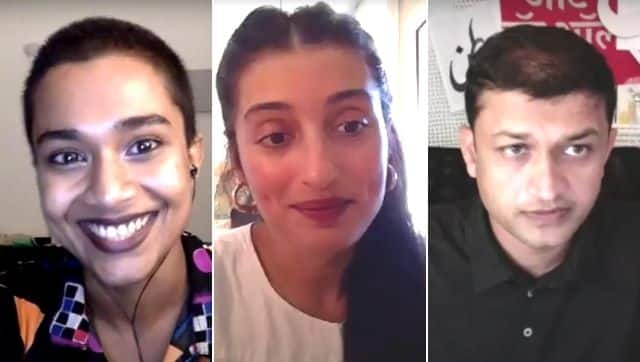 From left: Durga Gawde, Rithika Merchant, Hanif Kureshi[/caption] Durga draws one’s attention to a sketch from the series that captures the outlines of a fleeting corporal figure as if in motion — like a handful of feathers. “I draw the energy of a person, I draw the spirit of a person. I draw the atmosphere they create and the environment they pull towards them — how light and shadow falls. [I draw] how that translates the energy that goes into the image, and out into the world then.” The images have a strikingly meditative quality to them, as if following an invisible pulse or spark that brings alive a chimeric entity. The artist claims to flourish in pressure — a disposition all too familiar to prevailing society under the onslaught of a phantom virus, and a dogged presence in the individual’s life. Gawde has turned to utilising their otherwise sedentary time in lockdown to mobilise the trans community to claim their rightful space, initiating the move online through a comprehensive archive of over 100 drag kings from across the world. Under the hashtag #TheRainbowRevolution, the activist aims to open up the world of drag performances to anyone with access to an internet connection. This process, arguably, is in extension to the exploration of their gender non-conforming identity, as Gawde has been conscientiously striving to bring drag into fine art. “[In the pandemic], I’ve been connecting with other people like me who perform drag, and bring drag into the fine art world more seriously. It’s like combining painting, sculpture, performance, theatre, sound, music, pop culture. There is so much that goes into actually finding the strength to compile all of that visual information together, using all the sensory information around it as well, and then creating something that is not identifiable in the larger context of things, but it is identifiable in the context of gender identity. Taking that into the fine art world has been my mission personally,” they say. Besides, Durga Gawde also admits that the Indian art fraternity has been largely insular to the trans community, as they can recollect and count the number of times they have encountered a trans individual at a gallery opening or exhibition. “Maybe [seen] like one [trans-person] in 10 years [at a gallery opening]. I remember when I was a kid, every time I would go to a show with my parents…I remember in which show I saw someone who wasn’t supposed to be wearing a sari, wearing a sari. I remember women who had chin hair who showed up when I was eight years old…When you say the word ‘inclusive’, it doesn’t just talk about the artwork, but also about how we bring in people.” [caption id=“attachment_8764381” align=“alignnone” width=“640”] 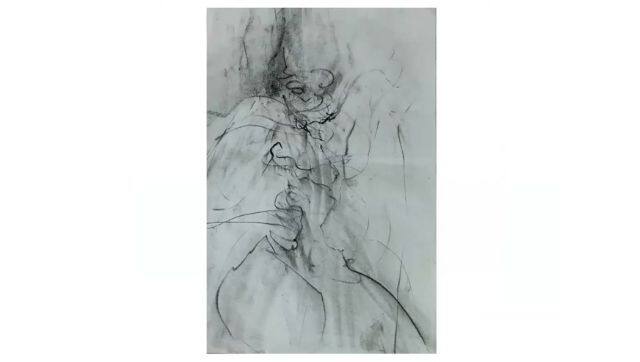 Artwork by Durga Gawde[/caption] Rithika Merchant claims to not have enough lived experience to attest to the lack of diversity and discrimination entrenched in the Indian art community. However, her oeuvre speaks of the most severe ongoing humanitarian crisis in the world — that of refugees. The rich, sparkling colours signature to Merchant’s art evoke the mythologies she uses as allegories to reflect on modern-day society. For her, the idea of identity funnels into a personal idiom from a larger collective one. For someone dividing her time between two continents, the term ‘identity’ connotes a ceaseless state of flux, as opposed to Durga’s intimate experience of a fluid state of self. “My work in the recent years has been exploring how objects can be markers of identity, and how these objects and markers, often in contemporary context, get completely reworked,” says the artist, as she goes on to display an artwork depicting the popular nimboo-mirchi totem from the subcontinent that is believed to ward off evil energies. “I try to work with symbols that will be recognisable to a lot of people…In my research I learned that this (nimboo-mirchi) was used by travellers way back when people used to walk through the jungles. Lemon mixed with water is just very hydrating. It’s lemonade, it’s delicious. But chillies were like the key thing,” she explains. Apparently, people took a bite of the chilly when bitten by a snake to test whether it was venomous. In the event that they could feel their tongue burn, they’d be assured that the snake was not poisonous, as its bite had not tampered with their sensory nerves. A second illustration, titled ‘Metropolis in flux’, alludes to the legend of Noah’s Ark, where a boat-like vessel is seen carrying people of various nationalities and ethnicities — like the different species of animals in the original — herded together in the middle of a turbulent sea, sailing off into an uncertain tomorrow. Similarly, a third one harks back to the episode of the ‘Fortunate Isles’ in Greek mythology, which refers to a desired land reserved for the most heroic people, who qualify for reincarnation thrice. They were also judged as “pure enough to gain entry into the Elysian Fields”. “I thought this was a very apt myth for what was going on at the moment, because during the height of this [refugee crisis], there were all these questions on who gets to enter a country, and [then there were] people who were being turned away for a variety of reasons,” the artist says. [caption id=“attachment_8764411” align=“alignnone” width=“640”] 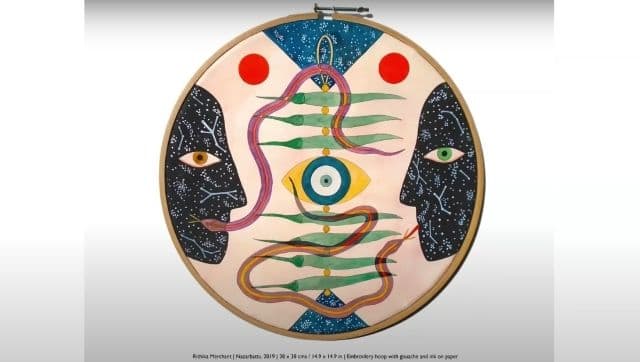 Rithika Merchant’s ‘Nazarbattu’[/caption] Her other artworks on display at the session included a “fantastic visualisation” of the Art Deco-style home in Mumbai she was raised in, besides another titled ‘The Matriarchy’, depicting anthropomorphised birds among blooming flora. The latter is Merchant’s nod to the ancient winged-women in Indian lore, conflated with the imagery of the fiercely feminist and independent ladies of the matrilineal state of Kerala, to which her mother belongs. Merchant explicitly explores her identity in the backdrop of her transcontinental existence through her art that occupies a significant fraction of her Instagram presence. While she admits to finding the platform exhausting on occasions, she credits it for its ‘democratic’ fervour, allowing artists to completely bypass the need for a ‘representative’ — a prerequisite when looking for physical space in galleries. However, “as much as I have a love-hate relationship with Instagram, it is a really great place to find a community,” she says. “It is worth it to use it, you know. I know it can fry people’s brains, but it is worth it to use it. And you can use it as little or as much as you want to, but definitely use it”— is her word of advice. The lockdown, however, has compelled Merchant to re-examine her relationship with social media, especially as an artist whose repertoire is a response to events unfolding in the tactile world beyond her screens. “At the moment, being indoors and not really being able to engage with the world that much has definitely forced me to look inward much more. Social media does become this window, because you can’t really go out and interact with anyone,” she points out. For her, “Instagram has been super overwhelming…It’s a weird thing, like you’re getting all these perspectives, but through the lens of social media, which never really feels like it’s real life, and you can experience it only as an outside viewer with no context.” [caption id=“attachment_8764421” align=“alignnone” width=“640”] 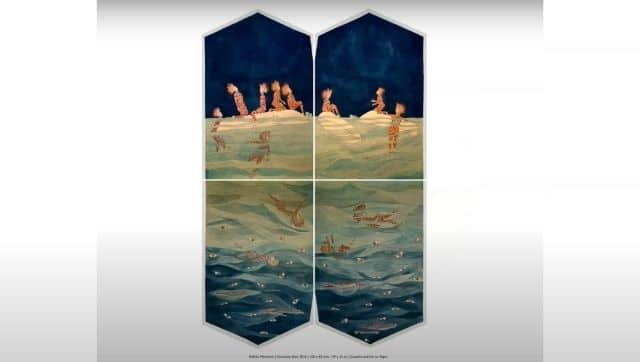 Rithika Merchant’s ‘Fortunate Isles’[/caption] But for Hanif Kureshi, art has predominantly existed in the great outdoors, on surfaces that have been deemed inaccessible — or even fatal — in a pandemic-ridden world. Dabbling in signages, street art, murals and graffiti involves community participation, which inherently implies human contact and touch, a concept now rendered outlandish to human society. He recognises the fact that in this new order, where commodities and services have been largely grouped into buckets of ‘must-haves’ and ‘good-to-haves’, art falls in the latter, even though he believes it is now, more than ever, that one needs to be surrounded by art. “Cities are under mental stress, and I think easing it out through (art) and making streets more positive and having more art on the streets would really help,” he says. As a part of St+Art India’s ongoing Mahim East Art District project in Mumbai, the team at the organisation led by Kureshi painted the Mahim Railway Station during lockdown, while maintaining protocols and taking adequate safety measures. “It’s a bit tough to work during this pandemic, but, if you’re looking at our practice that way, we are still working in isolation. We are not working in closed spaces,” Kureshi says. With cities and towns being forced to slowly inch back to ’normalcy’, despite the contagion raging in their backyards, Hanif believes it’s time to let art occupy more physical spaces instead of just digital ones. In addition to his fear of crafts like hand-painted signage facing extinction in an online ecosystem, the artist also shares how murals, street art and graffiti can go a long way in building important indices of identity for communities that create and surround them. From increased safety, to better mobility due to the creation of landmarks, to gains made by the local economy, St+Art India’s surveys in Delhi’s Lodhi Colony Art District have mostly revealed how art boosts the health of society. “The whole point is to let the common man experience art at a scale, which they would generally not get a chance to. Also, as a culture, we are not a museum-going or gallery-going country, so most of these works you stumble upon,” Kureshi says. For a place like Panjim, larger-than-life artworks such as the ones commissioned by Hanif, transform the small city into a walk-in art gallery. [caption id=“attachment_8764431” align=“alignnone” width=“640”] 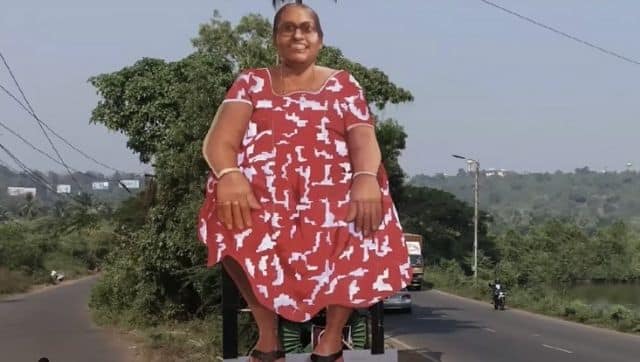 St+Art India Foundation’s ‘Cut-out Project’ in Panjim[/caption] While scrolling through images of the myriad artworks located in the six art districts he has helped establish — with glimpses of giant figure cutouts in Panjim, to B-boying figures on sooty walls of Dharavi, to sparkling abstract human figures in Hyderabad’s Maqta — Kureshi draws one’s attention to the shared experiences of the local community, in relation to the murals. “We established the Kannagi Art District in Chennai right before the lockdown, where close to 70,000-80,000 people live. By doing these works, there was a strong sense of community built between people, and when COVID-19 struck, it helped the authorities and communities to communicate with each other better through the project. They were able to control the spread of the virus much more efficiently than they were in other areas. Art made that happen, and this is something beyond our understanding as well,” he says. While painting on public property constitutes an approach of claiming spaces and histories that is subtly different from the one suggested by Gawde (where the trigger is more personal as opposed to the owning of a more collective identity), it has, more often than not, assumed political colour in the form of dissent and activism. “As an artist, one can take over the walls and public spaces to express themselves. Obviously, responsibility also comes into that, but at the same time, being anonymous in this street art world lets you do things that you normally can’t,” says Kureshi. He points to what Mumbai-based artist Tyler (pseudonym) has achieved through his ongoing project, ‘Walk of Shame’, under the cloak of anonymity. “There’s a sense of activism there, which he can do because he has kept his identity a secret. Instead of ‘Walk of Fame’, we ask people to submit names of people who would feature on the ‘Walk of Shame’. It’s a great way to put people’s thoughts on the streets,” he says. [caption id=“attachment_8764451” align=“alignnone” width=“640”] 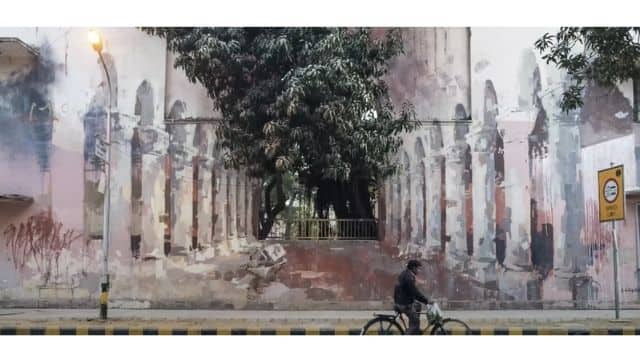 A mural in Delhi’s Lodhi Art District[/caption] At the same time, the very nature of street art, murals and graffiti is reflective of our ephemeral realities, where a sense of letting go and detachment is exercised. According to Hanif, their projects are not retouched or preserved, as it goes against the grain of the form. “Every street artist who works on walls doesn’t feel bad if their mural is not there the next day” — thereby humouring a form of vibrant dynamism and a spirit of change that is often synonymous with the contagious essence of street art. * Through the conversation, a delicate tussle between surrendering and taking control of personal and collective spaces emerges. This throws into sharp relief the contrasting ideas of identity espoused by the speakers and their chosen idioms of expression. For Durga Gawde, the cliché of ‘be the change you want to see’ has been more than just a maxim — it has been their way of life. As someone who has recently decided on surgically attaining the body they identify with, Durga’s craving for change and power to steer their own narrative is stronger than ever. Their 20-year-plan is to run for prime minister of India. “When you talk about the future, I am just fed up. And I am like, you know what? I want to be in a position of power with the perspective of a trans-person, and the thought process of an artist, while being articulate and educated, to make the changes that need to be made. It’s my 20 years of digital campaign [laughs],” they say, adding that they have been using their time to form a cabinet of ministers, with Anish Gawande, curator and co-founder of Pink List India, signing up to manage their digital campaign. However, tying all of their differing aspirations together, within and without the pandemic, is Rithika Merchant’s desire to create art uncompromisingly and fearlessly. “Going forward, I just hope I always have the freedom to express myself this way. It’s really important to make sure that we don’t have to create art under censorship — I think that’s my main worry. With the rise of right-wingers and nationalism…It’s a right we need to make sure we hold on to — the right to express ourselves freely,” she says, underlining the tenet that governs every life, every identity. * All images: YouTube screenshots
Artists Durga Gawde, Rithika Merchant and Hanif Kureshi reassess their art as extensions of their personal and collective identities in the light of the COVID-19 pandemic
Advertisement
End of Article


)
)
)
)
)
)
)
)
)



